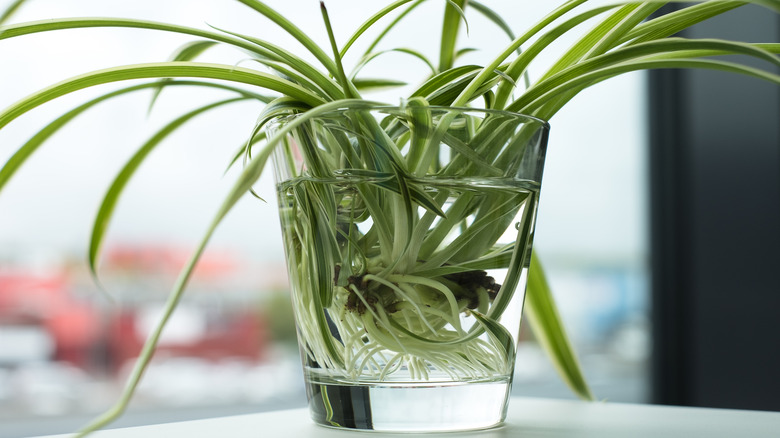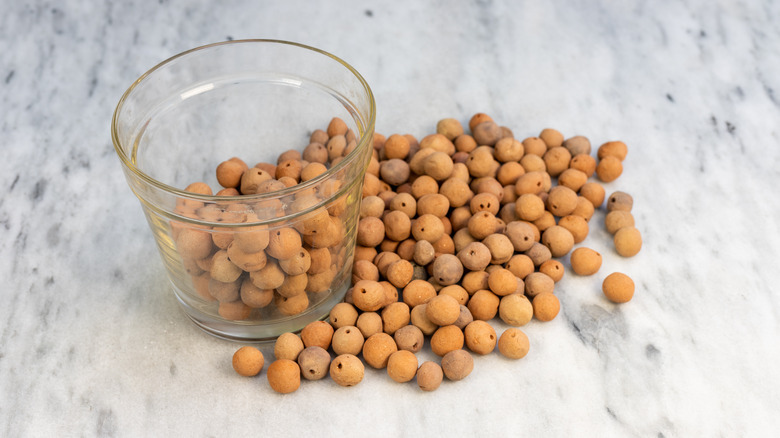Turns Out Your Spider Plant Doesn't Need Any Soil To Grow
The spider plant may not be as renowned as a certain web-slinging superhero, but this tough, adaptable plant packs some superpowers of its own. With the ability to send out runners, sprout dozens (if not hundreds) of spidery clones, and survive in various substrates, this plant is harder to kill than keep alive. If you believe there's no such thing as too many houseplants, you're in luck. You can take advantage of these plants' propagative powers to create a whole team of spider plant sidekicks. Best of all, you don't even need soil.
Spider plants (Chlorophytum comosum) are perennial herbaceous plants native to coastal regions of South Africa. A member of the asparagus family (Asparagaceae), these plants' tuberous roots and rhizomes store water, allowing them to survive droughts and forgetful plant parents. Spider plants get their common name from the dangling, spidery-looking offspring called spiderettes that form at the end of long, wiry stems called stolons. In the wild, these prolific progeny would take root in the soil and become new plants. However, these little sidekicks will happily grow in water and other soilless substrates, too. The roots that grow from the base of the spiderettes contribute to the plants' propagative prowess. Like all roots, these adventitious roots absorb oxygen from the air, but they can also extract oxygen from water, transforming these earth-bound plants into hardy hydroponic houseplants that can grow in water indefinitely.
How to grow spider plants in water
The easiest way to grow spider plants in water is to start with a spiderette. Larger spiderettes with starter roots growing from the base have higher survival rates, so be patient and give your little sidekicks time to grow. Using a sharp knife or pruning shears, cut the stolon close to the base of the spiderette and place it in a container of water. A small glass works well to start. Fill it with enough water to cover the bottom of the plant and any visible roots. Be sure to keep the leaves out of the water so they don't rot. The chlorine and fluoride in tap water may cause the leaves on your spider plant to turn brown. To prevent this, use distilled water, rainwater, or water collected from a dehumidifier.
While your spiderette is establishing roots, keep it in bright indirect light. Top off the water as needed to ensure the base of the plant stays submerged, and change out the water once a week. You should notice roots growing within 7 to 14 days. Plants normally get the nutrients they need from soil, so you'll need to add a liquid fertilizer to the water every few weeks. Look for one that is formulated for hydroponic environments. If you keep your spider plant in a clear glass container, you'll need to watch out for algae growth. You can use a sponge or brush to scrub off the algae during water changes.
Another way to grow spider plants without soil
Even superheroes need support sometimes. So, if your young spider plants have trouble staying upright in their aquatic abodes, a soilless substrate like LECA (lightweight expandable clay aggregate) can provide stability for the growing roots. LECA is a general term for porous clay pebbles that expand in water. When plants are potted in LECA, the roots absorb water from the pebbles. The air pockets between the LECA pebbles provide the roots with much-needed oxygen, which reduces the risk of root rot. Another benefit of growing houseplants in LECA is that the pebbles are lightweight compared to water.
If you want to grow spiderettes in LECA, it's best to start them in water and then transfer them once you see a couple of inches of root growth. When they're ready, fill a container with rinsed and pre-soaked LECA and then position the spiderette in the pebbles. Fill the container with water until the water level is just below the roots. The LECA wicks water up to the roots, so it's fine if they aren't submerged. Replace the water every week or two. LECA doesn't provide any nutrients, so you'll need a hydroponic fertilizer. Eventually, you'll want to move your growing spider plant to a two-pot system that allows you to easily change out the water and nutrients without disrupting the plant. Whatever method you choose, your spiderettes will quickly grow into their propagative powers, creating their own new teams of spider plant sidekicks.


